Legal Analysis: Sue's Claim of Negligence Against Peter
VerifiedAdded on 2020/03/07
|6
|1198
|74
Case Study
AI Summary
This assignment presents a case study analyzing the tort of negligence in the context of Sue's claim against Peter. The case revolves around an incident where Sue and her mother were confronted by two dogs due to an unlatched gate, resulting in Sue's mother suffering a fatal heart attack. The analysis delves into the essential elements of negligence, including the establishment of a duty of care, breach of that duty, and the resulting damages. It references key legal precedents such as Donoghue v Stevenson and Spandeck Engineering (S) Pte Ltd v Defence Science & Technology Agency, along with relevant Singaporean legislation. The assignment explores Peter's potential liability, considering foreseeability, breach of the standard of care, and the possibility of contributory negligence on Sue's part. The conclusion suggests that while Sue may have a claim, the damages could be reduced due to her actions. The assignment concludes by summarizing the key legal principles and their application to the case.
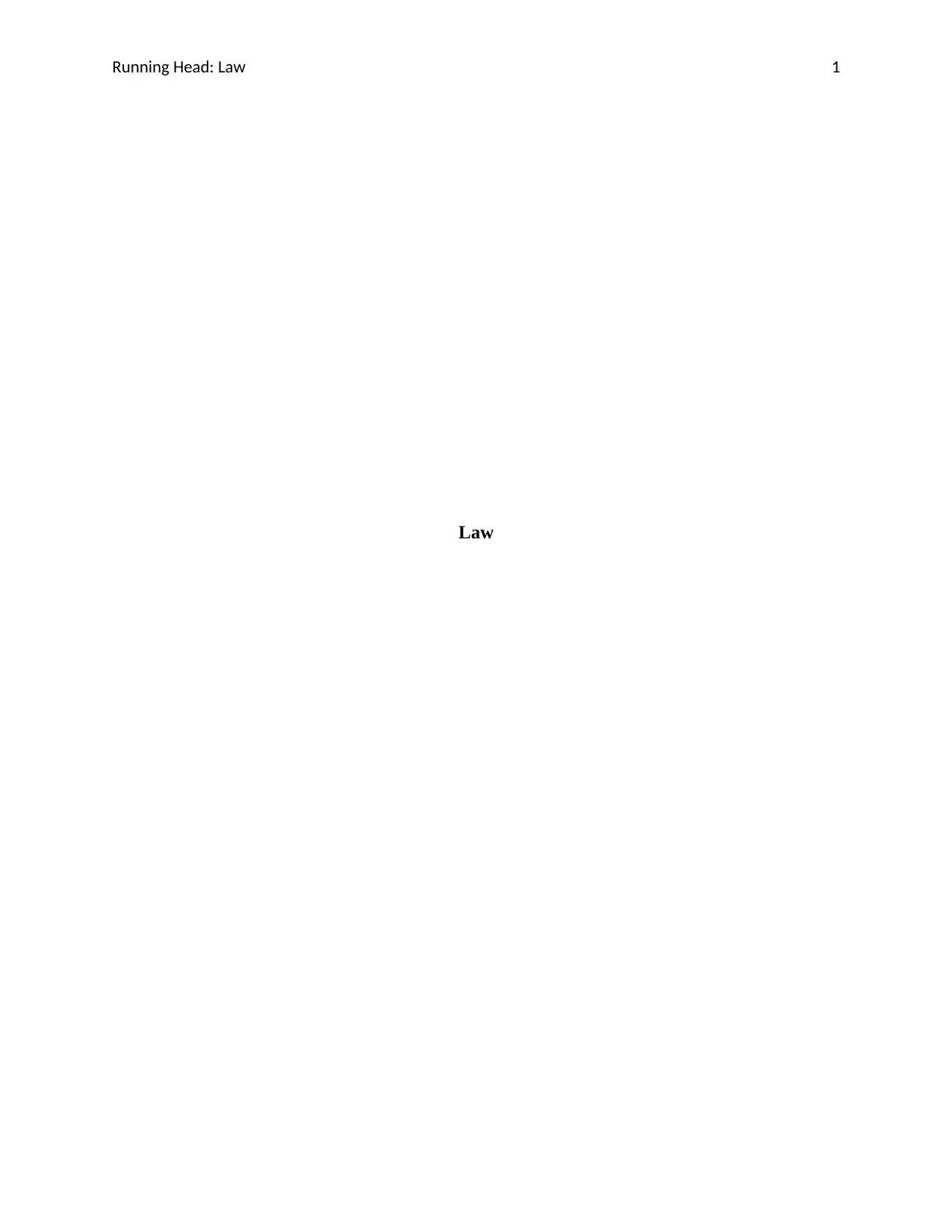
Running Head: Law 1
Law
Law
Paraphrase This Document
Need a fresh take? Get an instant paraphrase of this document with our AI Paraphraser
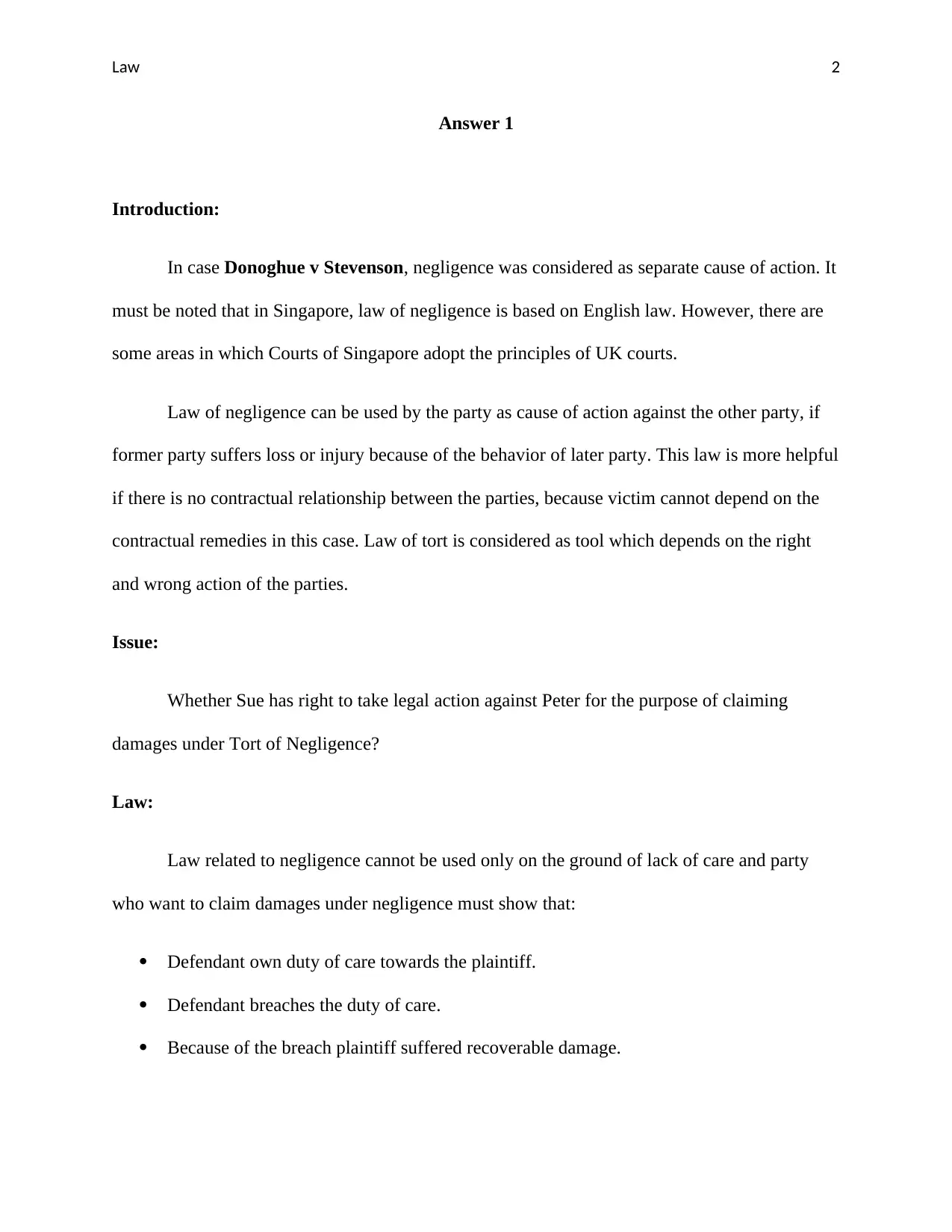
Law 2
Answer 1
Introduction:
In case Donoghue v Stevenson, negligence was considered as separate cause of action. It
must be noted that in Singapore, law of negligence is based on English law. However, there are
some areas in which Courts of Singapore adopt the principles of UK courts.
Law of negligence can be used by the party as cause of action against the other party, if
former party suffers loss or injury because of the behavior of later party. This law is more helpful
if there is no contractual relationship between the parties, because victim cannot depend on the
contractual remedies in this case. Law of tort is considered as tool which depends on the right
and wrong action of the parties.
Issue:
Whether Sue has right to take legal action against Peter for the purpose of claiming
damages under Tort of Negligence?
Law:
Law related to negligence cannot be used only on the ground of lack of care and party
who want to claim damages under negligence must show that:
Defendant own duty of care towards the plaintiff.
Defendant breaches the duty of care.
Because of the breach plaintiff suffered recoverable damage.
Answer 1
Introduction:
In case Donoghue v Stevenson, negligence was considered as separate cause of action. It
must be noted that in Singapore, law of negligence is based on English law. However, there are
some areas in which Courts of Singapore adopt the principles of UK courts.
Law of negligence can be used by the party as cause of action against the other party, if
former party suffers loss or injury because of the behavior of later party. This law is more helpful
if there is no contractual relationship between the parties, because victim cannot depend on the
contractual remedies in this case. Law of tort is considered as tool which depends on the right
and wrong action of the parties.
Issue:
Whether Sue has right to take legal action against Peter for the purpose of claiming
damages under Tort of Negligence?
Law:
Law related to negligence cannot be used only on the ground of lack of care and party
who want to claim damages under negligence must show that:
Defendant own duty of care towards the plaintiff.
Defendant breaches the duty of care.
Because of the breach plaintiff suffered recoverable damage.
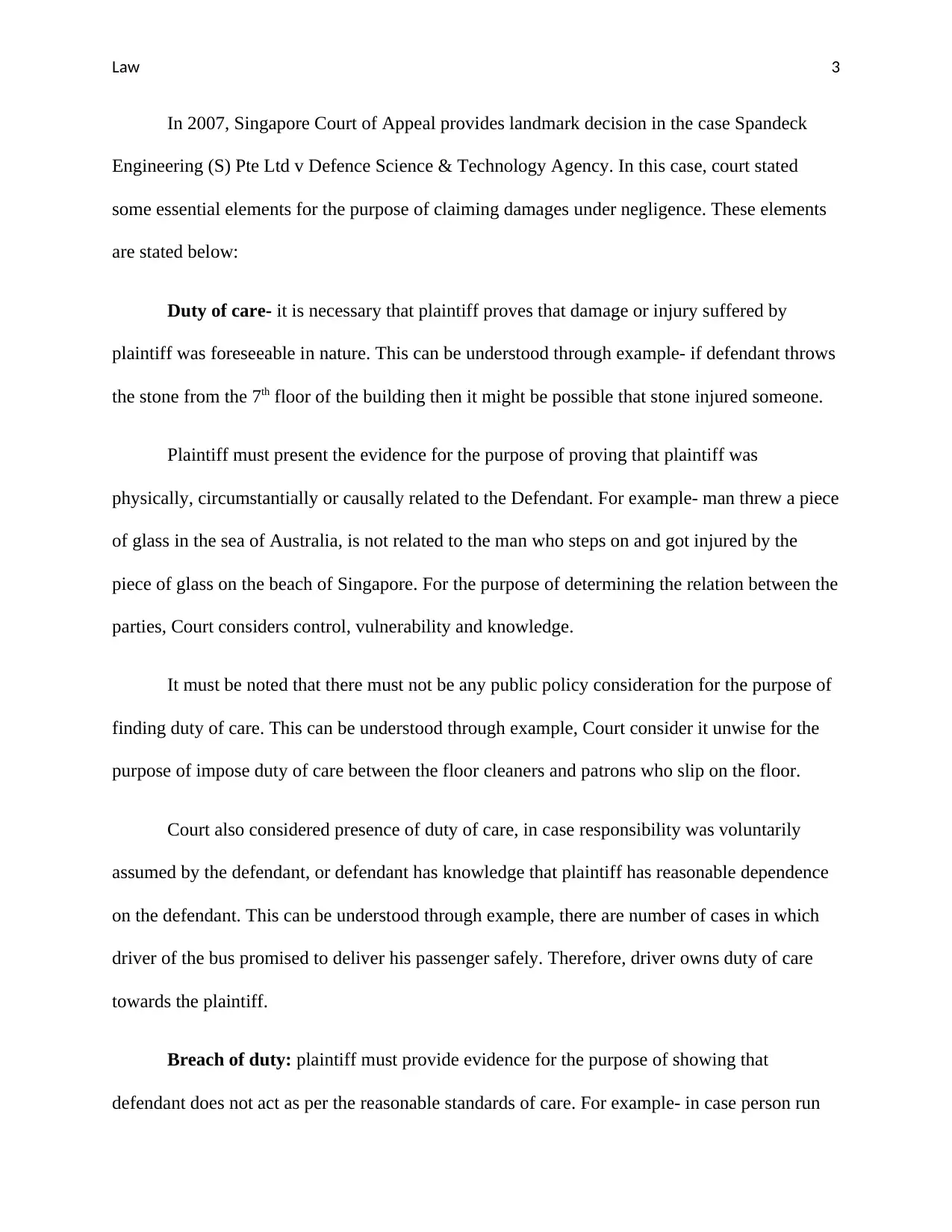
Law 3
In 2007, Singapore Court of Appeal provides landmark decision in the case Spandeck
Engineering (S) Pte Ltd v Defence Science & Technology Agency. In this case, court stated
some essential elements for the purpose of claiming damages under negligence. These elements
are stated below:
Duty of care- it is necessary that plaintiff proves that damage or injury suffered by
plaintiff was foreseeable in nature. This can be understood through example- if defendant throws
the stone from the 7th floor of the building then it might be possible that stone injured someone.
Plaintiff must present the evidence for the purpose of proving that plaintiff was
physically, circumstantially or causally related to the Defendant. For example- man threw a piece
of glass in the sea of Australia, is not related to the man who steps on and got injured by the
piece of glass on the beach of Singapore. For the purpose of determining the relation between the
parties, Court considers control, vulnerability and knowledge.
It must be noted that there must not be any public policy consideration for the purpose of
finding duty of care. This can be understood through example, Court consider it unwise for the
purpose of impose duty of care between the floor cleaners and patrons who slip on the floor.
Court also considered presence of duty of care, in case responsibility was voluntarily
assumed by the defendant, or defendant has knowledge that plaintiff has reasonable dependence
on the defendant. This can be understood through example, there are number of cases in which
driver of the bus promised to deliver his passenger safely. Therefore, driver owns duty of care
towards the plaintiff.
Breach of duty: plaintiff must provide evidence for the purpose of showing that
defendant does not act as per the reasonable standards of care. For example- in case person run
In 2007, Singapore Court of Appeal provides landmark decision in the case Spandeck
Engineering (S) Pte Ltd v Defence Science & Technology Agency. In this case, court stated
some essential elements for the purpose of claiming damages under negligence. These elements
are stated below:
Duty of care- it is necessary that plaintiff proves that damage or injury suffered by
plaintiff was foreseeable in nature. This can be understood through example- if defendant throws
the stone from the 7th floor of the building then it might be possible that stone injured someone.
Plaintiff must present the evidence for the purpose of proving that plaintiff was
physically, circumstantially or causally related to the Defendant. For example- man threw a piece
of glass in the sea of Australia, is not related to the man who steps on and got injured by the
piece of glass on the beach of Singapore. For the purpose of determining the relation between the
parties, Court considers control, vulnerability and knowledge.
It must be noted that there must not be any public policy consideration for the purpose of
finding duty of care. This can be understood through example, Court consider it unwise for the
purpose of impose duty of care between the floor cleaners and patrons who slip on the floor.
Court also considered presence of duty of care, in case responsibility was voluntarily
assumed by the defendant, or defendant has knowledge that plaintiff has reasonable dependence
on the defendant. This can be understood through example, there are number of cases in which
driver of the bus promised to deliver his passenger safely. Therefore, driver owns duty of care
towards the plaintiff.
Breach of duty: plaintiff must provide evidence for the purpose of showing that
defendant does not act as per the reasonable standards of care. For example- in case person run
⊘ This is a preview!⊘
Do you want full access?
Subscribe today to unlock all pages.

Trusted by 1+ million students worldwide
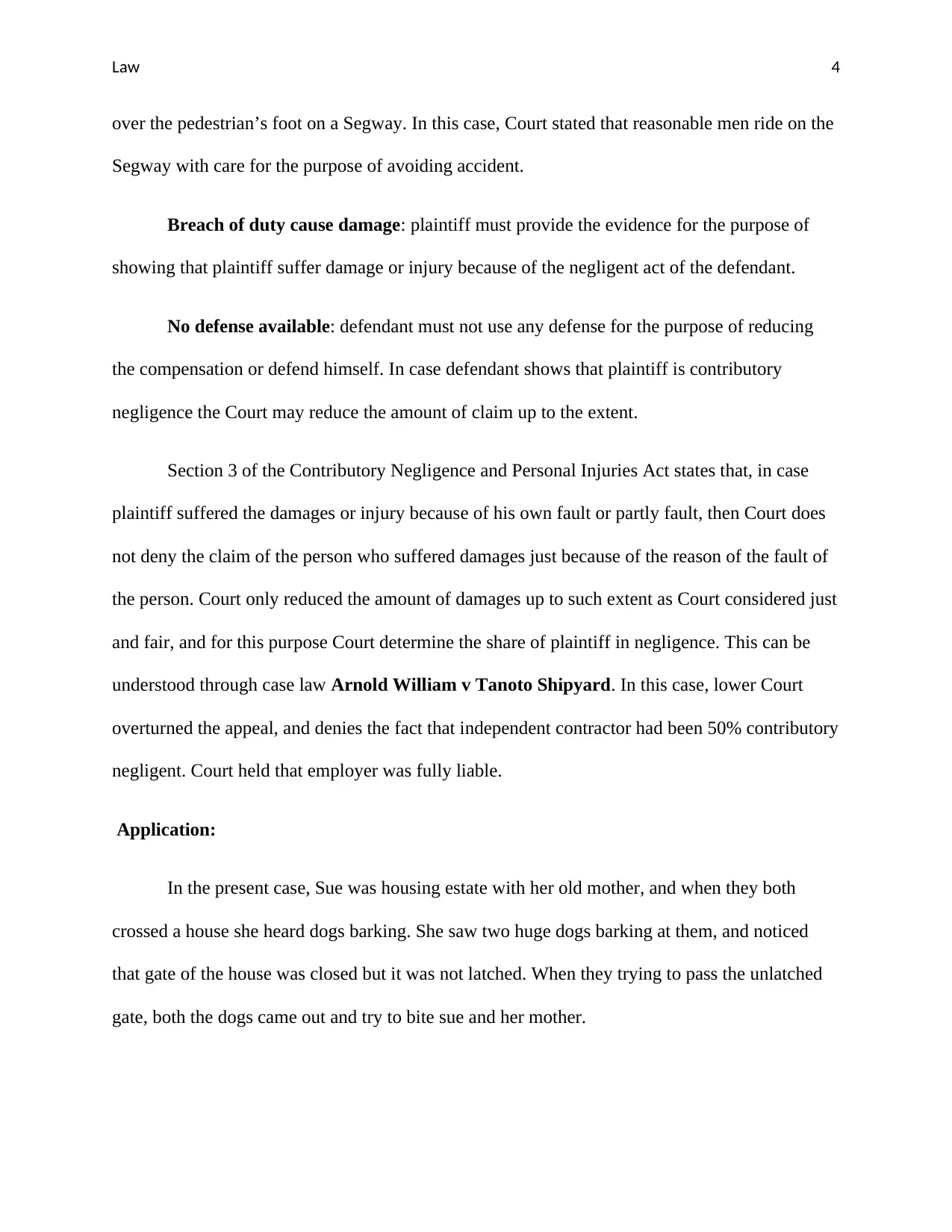
Law 4
over the pedestrian’s foot on a Segway. In this case, Court stated that reasonable men ride on the
Segway with care for the purpose of avoiding accident.
Breach of duty cause damage: plaintiff must provide the evidence for the purpose of
showing that plaintiff suffer damage or injury because of the negligent act of the defendant.
No defense available: defendant must not use any defense for the purpose of reducing
the compensation or defend himself. In case defendant shows that plaintiff is contributory
negligence the Court may reduce the amount of claim up to the extent.
Section 3 of the Contributory Negligence and Personal Injuries Act states that, in case
plaintiff suffered the damages or injury because of his own fault or partly fault, then Court does
not deny the claim of the person who suffered damages just because of the reason of the fault of
the person. Court only reduced the amount of damages up to such extent as Court considered just
and fair, and for this purpose Court determine the share of plaintiff in negligence. This can be
understood through case law Arnold William v Tanoto Shipyard. In this case, lower Court
overturned the appeal, and denies the fact that independent contractor had been 50% contributory
negligent. Court held that employer was fully liable.
Application:
In the present case, Sue was housing estate with her old mother, and when they both
crossed a house she heard dogs barking. She saw two huge dogs barking at them, and noticed
that gate of the house was closed but it was not latched. When they trying to pass the unlatched
gate, both the dogs came out and try to bite sue and her mother.
over the pedestrian’s foot on a Segway. In this case, Court stated that reasonable men ride on the
Segway with care for the purpose of avoiding accident.
Breach of duty cause damage: plaintiff must provide the evidence for the purpose of
showing that plaintiff suffer damage or injury because of the negligent act of the defendant.
No defense available: defendant must not use any defense for the purpose of reducing
the compensation or defend himself. In case defendant shows that plaintiff is contributory
negligence the Court may reduce the amount of claim up to the extent.
Section 3 of the Contributory Negligence and Personal Injuries Act states that, in case
plaintiff suffered the damages or injury because of his own fault or partly fault, then Court does
not deny the claim of the person who suffered damages just because of the reason of the fault of
the person. Court only reduced the amount of damages up to such extent as Court considered just
and fair, and for this purpose Court determine the share of plaintiff in negligence. This can be
understood through case law Arnold William v Tanoto Shipyard. In this case, lower Court
overturned the appeal, and denies the fact that independent contractor had been 50% contributory
negligent. Court held that employer was fully liable.
Application:
In the present case, Sue was housing estate with her old mother, and when they both
crossed a house she heard dogs barking. She saw two huge dogs barking at them, and noticed
that gate of the house was closed but it was not latched. When they trying to pass the unlatched
gate, both the dogs came out and try to bite sue and her mother.
Paraphrase This Document
Need a fresh take? Get an instant paraphrase of this document with our AI Paraphraser
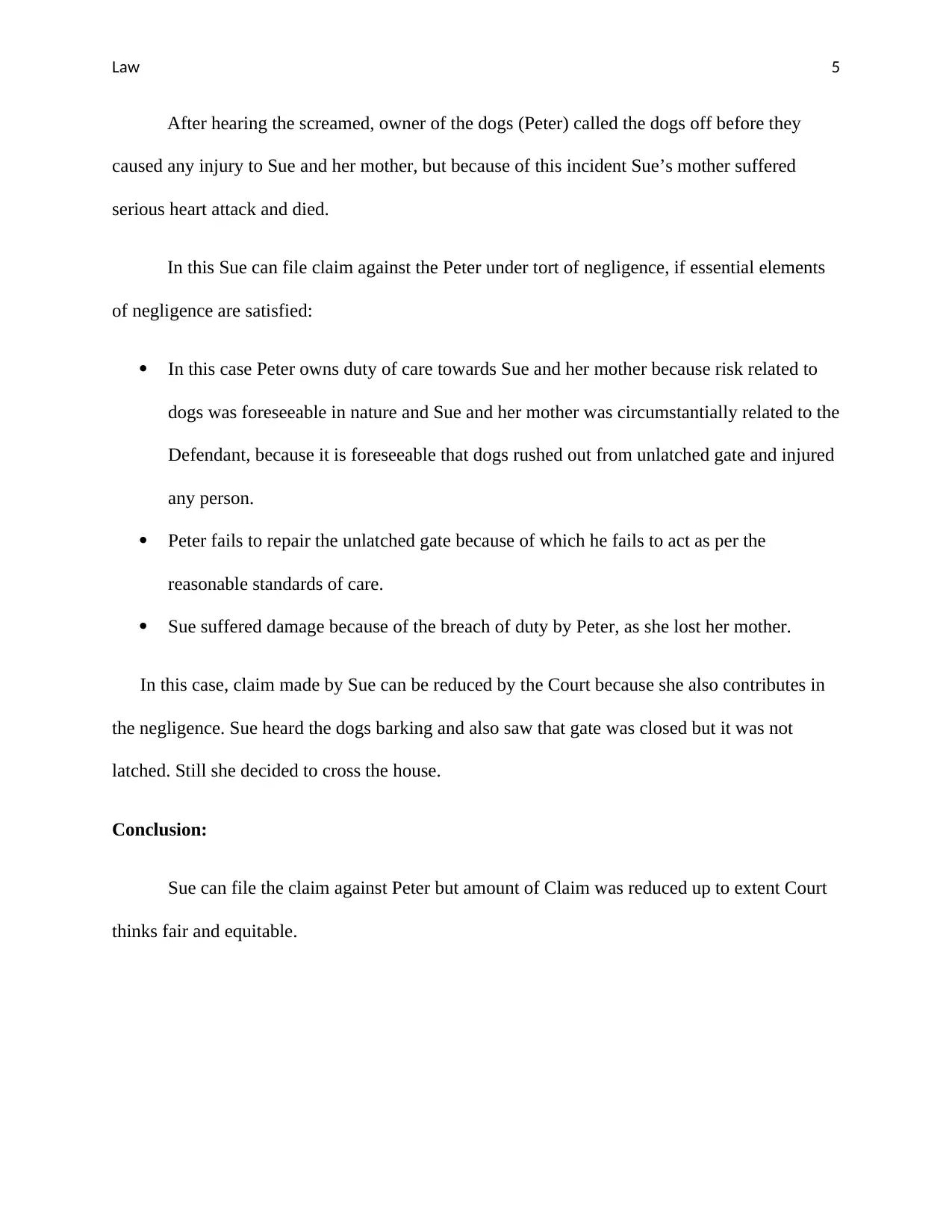
Law 5
After hearing the screamed, owner of the dogs (Peter) called the dogs off before they
caused any injury to Sue and her mother, but because of this incident Sue’s mother suffered
serious heart attack and died.
In this Sue can file claim against the Peter under tort of negligence, if essential elements
of negligence are satisfied:
In this case Peter owns duty of care towards Sue and her mother because risk related to
dogs was foreseeable in nature and Sue and her mother was circumstantially related to the
Defendant, because it is foreseeable that dogs rushed out from unlatched gate and injured
any person.
Peter fails to repair the unlatched gate because of which he fails to act as per the
reasonable standards of care.
Sue suffered damage because of the breach of duty by Peter, as she lost her mother.
In this case, claim made by Sue can be reduced by the Court because she also contributes in
the negligence. Sue heard the dogs barking and also saw that gate was closed but it was not
latched. Still she decided to cross the house.
Conclusion:
Sue can file the claim against Peter but amount of Claim was reduced up to extent Court
thinks fair and equitable.
After hearing the screamed, owner of the dogs (Peter) called the dogs off before they
caused any injury to Sue and her mother, but because of this incident Sue’s mother suffered
serious heart attack and died.
In this Sue can file claim against the Peter under tort of negligence, if essential elements
of negligence are satisfied:
In this case Peter owns duty of care towards Sue and her mother because risk related to
dogs was foreseeable in nature and Sue and her mother was circumstantially related to the
Defendant, because it is foreseeable that dogs rushed out from unlatched gate and injured
any person.
Peter fails to repair the unlatched gate because of which he fails to act as per the
reasonable standards of care.
Sue suffered damage because of the breach of duty by Peter, as she lost her mother.
In this case, claim made by Sue can be reduced by the Court because she also contributes in
the negligence. Sue heard the dogs barking and also saw that gate was closed but it was not
latched. Still she decided to cross the house.
Conclusion:
Sue can file the claim against Peter but amount of Claim was reduced up to extent Court
thinks fair and equitable.
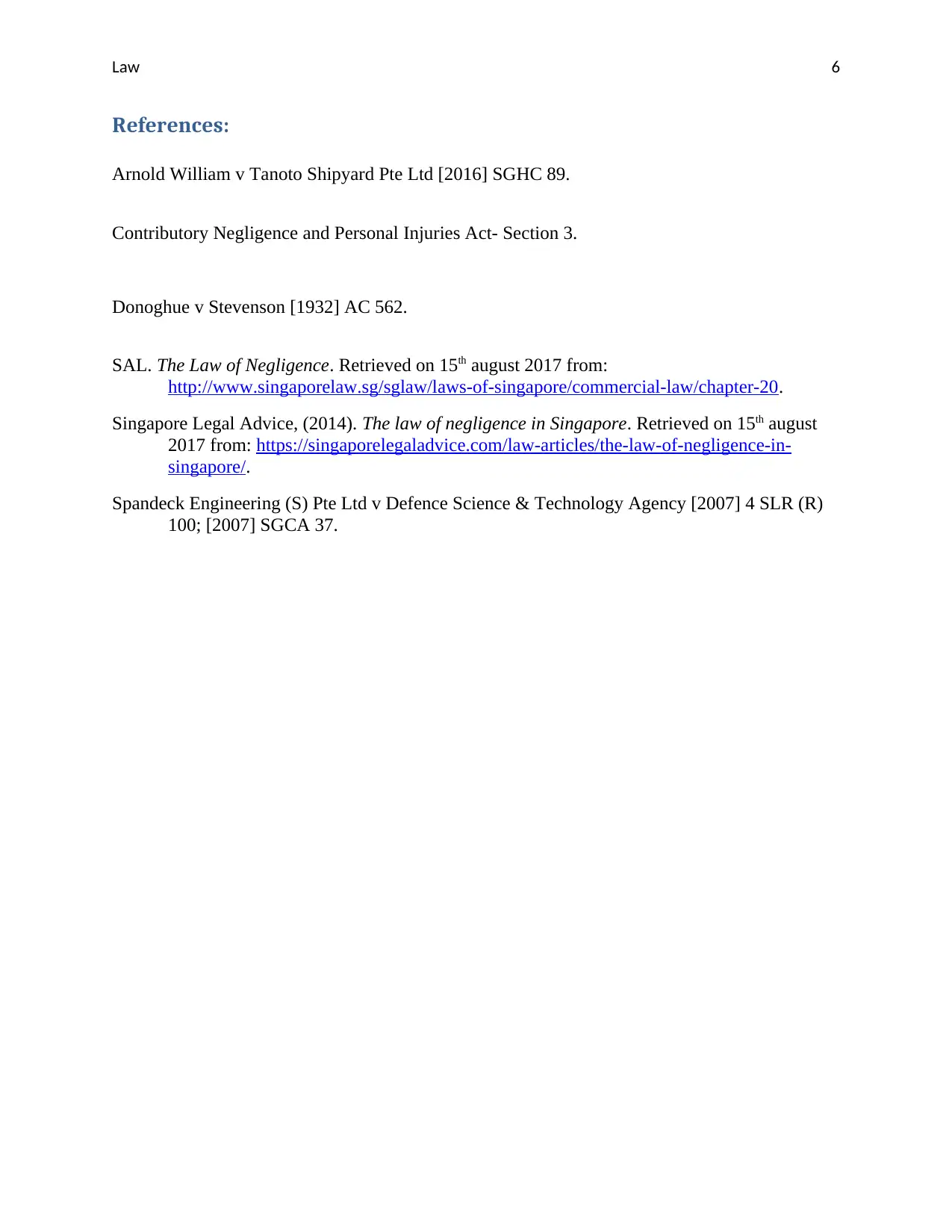
Law 6
References:
Arnold William v Tanoto Shipyard Pte Ltd [2016] SGHC 89.
Contributory Negligence and Personal Injuries Act- Section 3.
Donoghue v Stevenson [1932] AC 562.
SAL. The Law of Negligence. Retrieved on 15th august 2017 from:
http://www.singaporelaw.sg/sglaw/laws-of-singapore/commercial-law/chapter-20.
Singapore Legal Advice, (2014). The law of negligence in Singapore. Retrieved on 15th august
2017 from: https://singaporelegaladvice.com/law-articles/the-law-of-negligence-in-
singapore/.
Spandeck Engineering (S) Pte Ltd v Defence Science & Technology Agency [2007] 4 SLR (R)
100; [2007] SGCA 37.
References:
Arnold William v Tanoto Shipyard Pte Ltd [2016] SGHC 89.
Contributory Negligence and Personal Injuries Act- Section 3.
Donoghue v Stevenson [1932] AC 562.
SAL. The Law of Negligence. Retrieved on 15th august 2017 from:
http://www.singaporelaw.sg/sglaw/laws-of-singapore/commercial-law/chapter-20.
Singapore Legal Advice, (2014). The law of negligence in Singapore. Retrieved on 15th august
2017 from: https://singaporelegaladvice.com/law-articles/the-law-of-negligence-in-
singapore/.
Spandeck Engineering (S) Pte Ltd v Defence Science & Technology Agency [2007] 4 SLR (R)
100; [2007] SGCA 37.
⊘ This is a preview!⊘
Do you want full access?
Subscribe today to unlock all pages.

Trusted by 1+ million students worldwide
1 out of 6
Related Documents
Your All-in-One AI-Powered Toolkit for Academic Success.
+13062052269
info@desklib.com
Available 24*7 on WhatsApp / Email
![[object Object]](/_next/static/media/star-bottom.7253800d.svg)
Unlock your academic potential
Copyright © 2020–2025 A2Z Services. All Rights Reserved. Developed and managed by ZUCOL.





